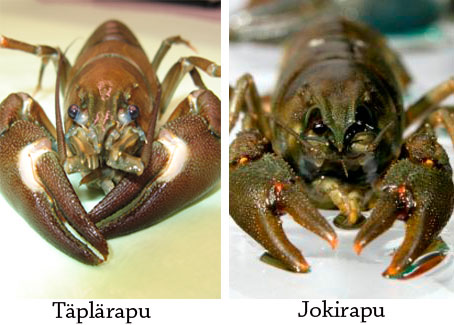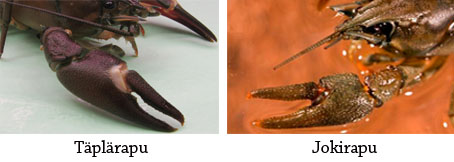Crayfishing permit
Metsähallitus offers crayfishing opportunities throughout Finland. Crayfishing is permitted in crayfishing waters administered by Metsähallitus with a crayfishing permit issued by Metsähallitus. Crayfishers 18–69 years of age must also pay the fisheries management fee, which may be purchased, for example, from the Eräluvat online store (verkkokauppa.eraluvat.fi). The obligation to pay does not apply to crayfishers who have reached the age of 65 or more by 31 December 2023.
In 2024, the crayfishing season begins on 21 July at 12.00 pm (noon) and ends on 31 October.
The indigenous noble crayfish or introduced American signal crayfish can be found at fishing destinations. We would like that every crayfisher be able to distinguish noble crayfish from the signal crayfish and understand why preventing crayfish plague is the crayfisher's most important task. Please read the crayfishing instructions and information carefully before crayfishing. You can read more about crayfish plague below (under Crayfish plague).
Remember to also fill out and return the catch report after crayfishing.
Purchasing information
The price of the crayfishing permit depends on how many pots or other types of traps will be used under the permit. The price for using a single pot or other trap is 8 euros. The crayfishing permit is valid for the entire crayfishing season. The permit also includes the right to keep crayfish in one corf in the same water where they are caught.
The sale of crayfishing permits for a given crayfishing destination depends on the size of the crayfish population and the pot quota. A pot quota for a single crayfisher varies from site to site. A crayfisher-specific pot restriction is used in an effort to ensure crayfishing opportunities for as many subsistence fishers as possible. There is also a quota for the total number of pots to be used under permits sold for sites.
The sale of crayfishing permits starts on 1 July 2024. Prior to purchasing a crayfishing permit, you should read the Metsähallitus terms of purchase and cancellation for permits.
Metsähallitus crayfishing permits may be purchased from the Eräluvat phone service. The service is open on weekdays from 9 AM to 3 PM.
Rules
- The crayfisher is required to attach their name and phone number on the trap.
- When crayfishing in waters administered by Metsähallitus, the minimum size of crayfish is 10 centimetres. Crayfish are measured from the rostrum (nose) to the tip of the uropod (tail fin). Crayfish less than 10 cm in length must be released at the catch site.
- After crayfishing, all crayfishers must submit a catch report. A crayfishing report is sent to crayfishers with the crayfishing permit.
Permit areas
Learn more about Metsähallitus crayfishing waters (in Finnish) or call the service number for further information.
Crayfish plague
Crayfish plague prevention
One of the threats facing crayfish in Finland is crayfish plague, which is spread by signal crayfish. Preventing the spread of crayfish plague and protecting the indigenous noble crayfish involves all crayfishers.
Preventing the spread of the disease is simple:
- Use only frozen bait or bait originating from the area where you are crayfishing.
- Do not transfer crayfish to other water areas without the proper permit.
- Only keep crayfish you have caught in the section of water where you caught them.
In some cases, there is a need to move trapping and fishing tackle from one water area to another. Moving tackle is only safe when the traps have been properly cleaned and disinfected in two steps:
- First, thoroughly clean the traps with, for example, a pressure washer.
- Then fully dry the traps outside in the sun. This is the first phase of disinfection.
- In the second phase, the traps are disinfected in one of the following two ways:
- Boil the traps for ten minutes.
- Submerge the traps for 30 minutes in a 4% formalin or rectified spirit solution, with three parts rectified spirit (e.g. Sinol or Lasol) and one part water.
- Freeze at -20 degrees Celsius for at least two days. For example, trapping tackle should be stored in a cold and dry place during the winter.
- Dry in a sauna at +80 degrees Celsius for at least five hours.
Suspect crayfish plague?
Crayfish dies so quickly of crayfish plague that there is not enough time for easily identifiable external signs to develop. Suspected cases of crayfish plague usually do not raise any suspicions until dead crayfish are found or when catch numbers plummet.
The signal crayfish is responsible for spread of the plague. Dark spots found on the signal crayfish shell and in its joints are signs that the crayfish's defences are fighting the plague fungus It is assumed that nearly all signal crayfish are carriers of the disease. This is why there is no reason to send samples to the Finnish Food Authority for analysis unless the findings also involve mortality.
Where crayfish are concerned, deviations in their shell may indicate the presence of crayfish diseases. In such cases, you should send samples to the Finnish Food Authority. Shell deviations include clearly defined changes in colour and erosion.
Send samples to the Finnish Food Authority
Although sample analysis works best with live crayfish, freshly dead crayfish can also be sent for analysis.
You can find more information about crayfish plague and sending the analysis in Finnish Food Authority website (in finnish, ruokavirasto.fi)
Identifying crayfish species
Signal crayfish (täplärapu) usually have a well defined whitish or bluish patch at the base of the claw fingers. The claws of the noble crayfish (jokirapu) are the same colour as the shell.
How can small crayfish be identified if they have no claws? The noble crayfish has a row of clearly visible nodules on its side in the groove between the head and cephalothorax, while the signal crayfish shell is smooth throughout.


Information
For further information on crayfishing, please contact Metsähallitus Senior Specialists in Fisheries:
- Eastern Finland: Eetu Karhunen
- Western Finland: Veijo Honkanen
- Ostrobothnia and Kainuu: Pasi Korhonen
- Lapland: Markku Vierelä
Crayfishing destinations are announced each year just before the start of crayfishing season. Read more about the crayfishing destinations (in Finnish).
